Planting Potatoes the Grow Biointensive Way
This post may contain affiliate links, which means that I may receive a commission if you make a purchase using these links. As an Amazon Associate I earn from qualifying purchases.
Grow Biointensive is an organic agricultural system that focuses on attaining greatest yields from a small garden area. The process involves double-digging beds, feeding the soil with compost, and planting closely to conserve spacing and create a microclimate. This method uses less garden space and eliminates the labor of hilling your potatoes.
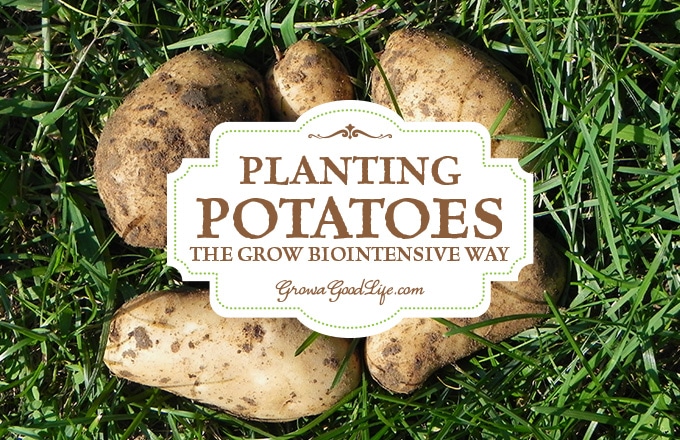
My first year of growing potatoes, I used the traditional trench method. This involves digging trenches two feet apart, mounding the soil in between the trenches, and using this soil to hill the potato plants as they grow. Although the crop was successful, I didn’t like the extra labor involved in hilling, the unkempt and messy appearance of the plot, and the wasted space in between the rows.
While I was growing my first batch of potatoes back in 2010, a fellow blogger, Laura was experimenting with John Jeavons’ Grow Biointensive potato planting method.
The Grow Biointensive program is made up of eight principles to grow healthy food naturally and care for the soil at the same time. The eight principles are: deep soil preparation, composting, intensive planting, companion planting, carbon farming, calorie farming, open-pollinated seeds, and whole system method. Learn more about Grow Biointensive.
Planting potatoes the Grow Biointensive way involves double-dug beds, feeding the soil with compost, and planting closely to conserve spacing and create a microclimate. The potato seeds are planted on top of the fluffed up soil, 9-inches apart and about 9-inches deep from the soil surface. The rows are planted in an offset, or diamond spacing. The closer spacing helps maximize space and creates a microclimate that shades out weeds and reduces moisture loss. The deep, 9-inch planting eliminates the need to hill your potatoes.
I was intrigued by this method, especially since Laura’s experiment was such a success. I did some further research and decided to try it the following year. I was so thrilled that my experiment worked even though I didn’t follow the instructions exactly! I had an abundant potato harvest that year providing plenty of potatoes for winter food storage.
I have modified the method a little over the years. Since I don’t walk on my garden beds, there is no need to double dig each year. Once your soil is loose and healthy, adding some finished compost and organic amendments at planting time is all that you will need to do. The instructions below assume you have never double dug your gardening beds.
Also See: 8 Great Tips for Growing Potatoes
How to Plant Potatoes the Biointensive Way:
Step 1: Make a measuring board:
It is helpful to use a measuring board to place across your gardening bed to mark the spacing of your planting holes. I use a 2×4 scrap board and mark out 9-inch intervals on one side with a marker, then turn the board over and mark out 9-inch intervals on the other side but off set from the first side. So all I have to do is flip the board over to measure the next row creating a diamond pattern.
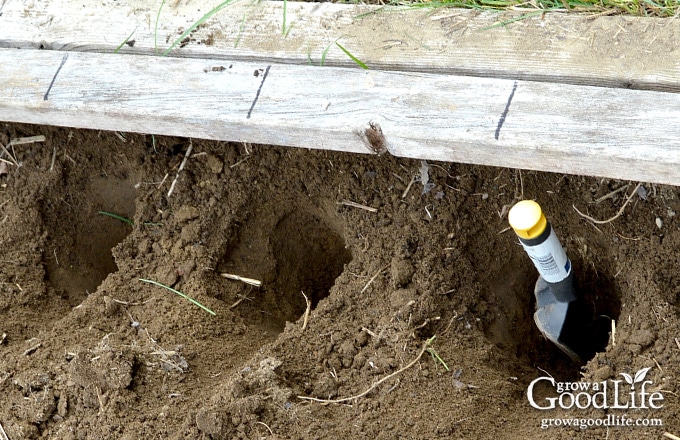
Step 2: Double dig and plant your potato bed:
You will be double digging and planting your potato seeds at the same time. The first step is digging a row about 12-inches deep. The soil from this first row is placed into a wheelbarrow and set aside. Once the row is dug, add some finished compost and an organic fertilizer to the trench. Use a digging fork to mix in the amendments and loosen the soil in the trench to a depth of another 12 inches. This will allow oxygen into the soil and helps the roots to penetrate easier.

Step 3: Plant your seed potatoes:
Place your measuring board across the bed and mark out your planting holes. You are aiming to plant your seed about 9-inches below the soil surface. Since the soil is fluffed up, you may need to dig down into the soil to be sure your planting holes are 9-inches deep. You can use a hand trowel or even a large bulb planter. Place your potato seeds into the holes along the trench with the sprouts facing up. Once the first row is planted, you will be covering it with the soil from the next row.
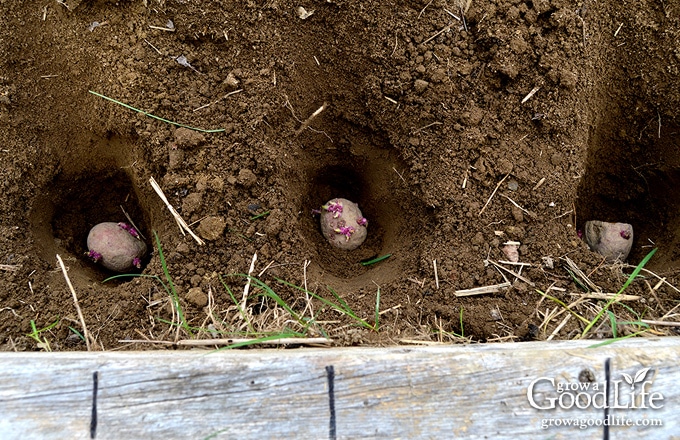
Step 4: Plant your next row:
Measure the next row 9-inches away from the first and begin digging your second row about 12-inches deep. As you dig, use the soil from the second row to cover the first. Add your amendments, mix in and loosen the soil another 12-inches with a digging fork. Flip your planting board over and plot out your planting holes. Remember, these should be spaced offset from the previous row. Continue in the same way until you have planted all your potato seed. Once you have reached the final row, cover the trench with the reserved soil from the wheelbarrow.
Step 5: Mulch the potato bed:
Once the bed is planted, string soaker hoses (if using) along the rows and water well. Mulch the bed heavily to help retain moisture, reduce weeds, and keep the light from reaching any potatoes that reach the soil surface. I like using straw as mulch, but also use shredded leaves if straw isn’t available. Your potato plants should emerge from the soil in about two weeks. It may take longer if the soil is still cold.
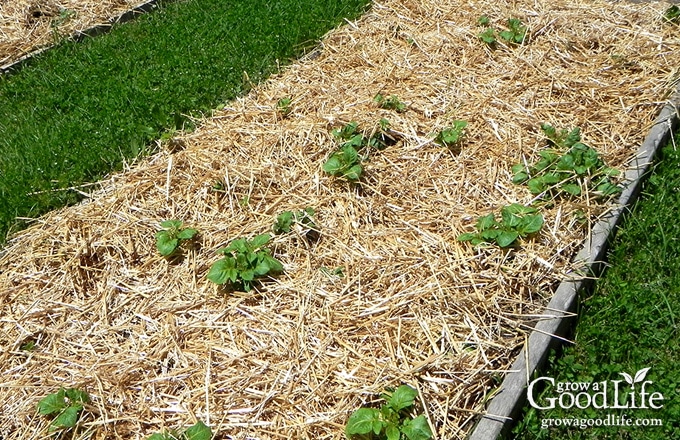
Step 6: Add poles and twine for support:
Add four poles to the corners of your potato bed and string some twine to provide support as the potato plants grow. In the book, The Sustainable Vegetable Garden, John Jeavons suggests that staking potatoes helps the plants to remain upright creating a microclimate to keep the plants and soil cooler. This will also keep the plants from flopping into the walking paths.

Step 7: Harvest your potatoes:
Baby potatoes are delicious. Once the potato plants bloom, you can begin harvesting potatoes as needed for meals. Dig carefully beneath the soil and pull out what you need. Try not to damage too many roots so the plant can continue growing. If you are growing potatoes for storage, allow the tubers to remain in the ground to mature fully.

Planting potatoes the Grow Biointensive way has served me well over the past few years so I haven’t tried too many different ways to grow potatoes, but thankfully many other bloggers have, and they allowed me to share their experiences. Check out 6 Ways to Grow Potatoes for more ideas on how to plant your potatoes.
References and Further Reading
- How to Grow More Vegetables Than You Ever Thought Possible
- The Sustainable Vegetable Garden: A Backyard Guide to Healthy Soil and Higher Yields
- Grow Biointensive Website
- A Farmer’s Mini Handbook: Grow Biointensive Sustainable Mini-Farming PDF
Want to Learn How to Grow Potatoes?
You will find everything you need to start growing potatoes in my PDF eBook, Grow a Good Life Guide to Growing Potatoes. Whether you are striving for a few gourmet fingerling potatoes or a large crop for winter food storage, this guide will show how you can grow your own, organic, homegrown potatoes.
You May Also Like:
- How to Grow Potatoes: Trench and Hill Method
- Sourcing Seed Potatoes for the Backyard Garden
- Chitting Potatoes Gives them a Head Start
- 5 Steps to Storing Potatoes for Winter
- Baked Seasoned French Fries Recipe
- Harvest Hearty Beef Stew Recipe
Good planning is key to a successful vegetable garden
Whether you are new to growing your own food or have been growing a vegetable garden for years, you will benefit from some planning each year. You will find everything you need to organize and plan your vegetable garden in my PDF eBook, Grow a Good Life Guide to Planning Your Vegetable Garden.
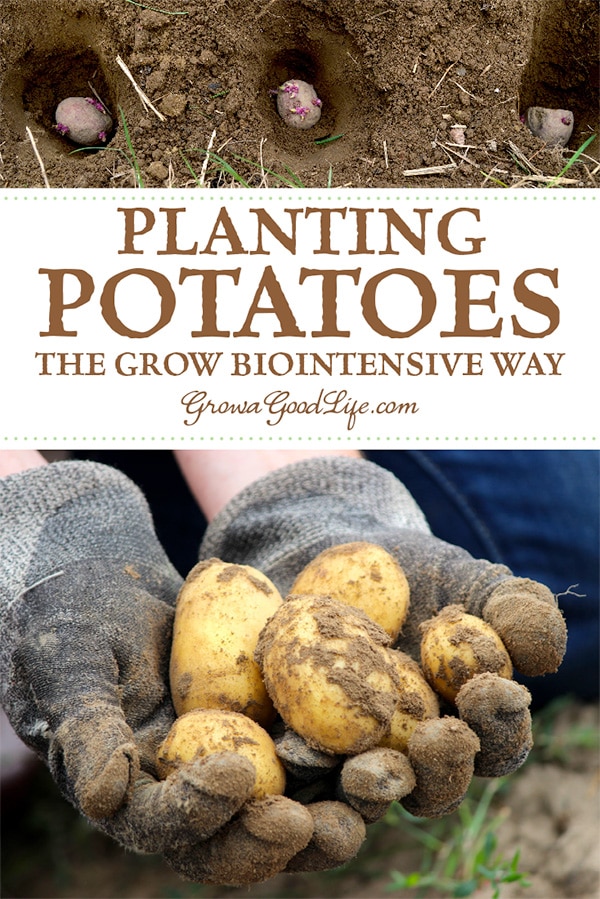


Just have a question on the planting depth, 9 inches deep and covered with the original 12 inches of topsoil, 21 inches, do the potatoes have a problem growing up through all of this. I normally plant around 3-4 inches deep.
J, The potatoes are planted only 9-inches below the soil level. Begin by double digging down to 12-inches, but once the amendments are added and the soil is fluffed up, the soil in the trench should be around 9-inches.
Just to make sure I understand. Are you burying the potatoes 21 inches deep from the top soil line?
Hi Sher, The seed potatoes end up planted only about 9 inches deep. You dig a 12-inch trench, add your fertilizer and compost, and loosen up the soil beneath the trench about another 12-inches with a digging fork. Then you end up placing your potato seeds about 9-inches from the soil surface once the soil is fluffed up and amended. Once the potatoes are planted, I mulch heavily with straw so any potatoes that pop up through the soil surface are protected from sunlight.
You’re very patient in the way you answer questions and the article itself is very informative, thanks!
Richard, Thank you for your kind comment. My goal is to try to educate.
I am wondering about your potato harvest. Was it satisfactory? I will be doing close spacing in my raised beds, was intending to plant under black plastic mulch for my early spuds. Did it work out o.k. for you?
Hi Steve, Yes, I did have a pretty good harvest even though the soil in that bed was pretty poor. The followup for that year is here: https://growagoodlife.com/digging-the-kennebec-and-dark-red-norland-potatoes/
I am wondering why you are planting your potatoes under black plastic though. I use straw or hay to mulch the potato beds. This allows the soil to breath and the potato plants to sprout up where they want to. Potatoes will sulk and might rot in soil that isn’t warm enough. I like to wait until the soil warms to 50˚F. You can use black plastic to help warm the bed previous to planting, but I suggest removing it to plant the seed potatoes and mulch with straw or hay.
thanks all for the tater talk! grafixmuse, if you’re willing, will you give us an update? (we’re in the nc foothills)
Hi there Anonymous! The followup can be found here: Digging the Kennebec and Dark Red Norland Potatoes
A bit of extra work in the spring will hopefully guarantee you a fine crop of potatoes!
I just love how neat and orderly they are.
I have used John Jeavons planting methods off and on for years, always with success, (not sure why I don’t use it all the time…) Keep us up to date on how this works with taters…I’d love to see results.